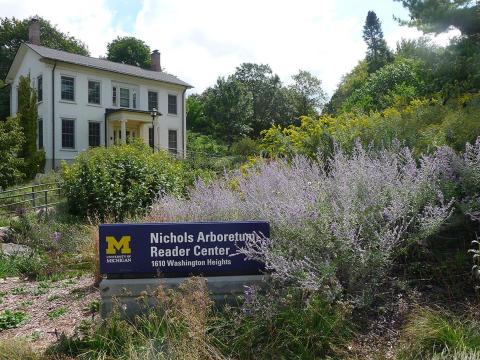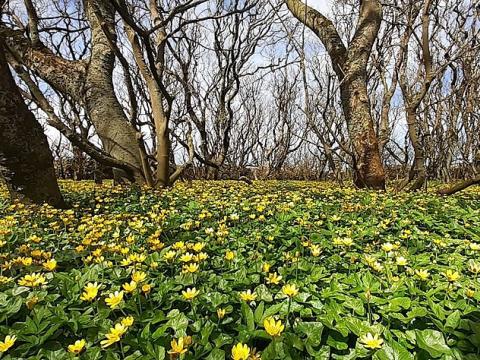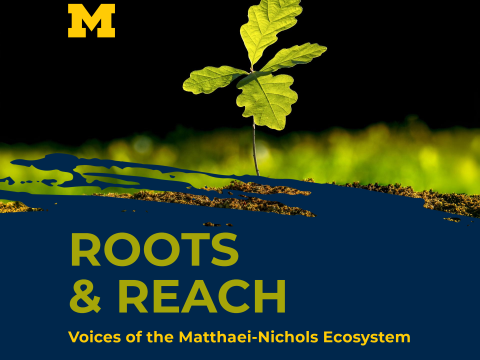
The native plant sale happens only once a year, but it is a full-time job! MBGNA staff and volunteers work in all seasons to make the native plant sale happen. Teams of students, volunteers, and staff collect seeds from the grounds at MBGNA, a process that requires patience, care, and impeccable timing—if they get there even a day too late, the seeds might be gone. This year, their efforts have yielded impressive results as they are growing over 7,000 plants. These plants are propagated from seed and are transplanted twice into larger containers to ensure they thrive and have ample room for growth.
There are so many reasons to plant native plants in your yard at home!
Roots & Runoff
Many native plants, like butterfly weed (Asclepias tuberosa), prairie dock (Silphium terebinthinaceum) and little bluestem (Schizachyrium scoparium) have deep root systems. In contrast, common lawn grasses like Kentucky bluegrass have shallow roots that only permeate the first few inches of soil. The deep root systems of native plants can mitigate stormwater run off by helping rainwater to infiltrate into the soil. By replacing lawns with native species, you can help build soil health and prevent erosion and runoff.
Serving Specialists
A whopping 90% of all insects are specialists, feeding solely on the pollen of a limited set of species they have evolved with over time. In the US, 30% of all bee species are picky eaters, needing certain native species to survive. Planting a variety of native species creates a diverse buffet that better supports a diversity of insects. This ripples up the food chain, with a greater diversity of insects in turn supporting a greater diversity of predators.
Host Sweet Host
While many pollinators feed solely on native plants, many adult pollinators will still feed on non-native plant species. However, when it comes to laying their young, many native pollinators are specialists, often only able to use a few specific host plants that they have co-evolved alongside for thousands of years. For example, while adult monarchs feed on various species, both native and non-native, their larvae feed solely on native milkweed species making this plant essential for the monarch's survival.
Native Niches
Native plants also help to foster habitat for threatened and endangered species. MBGNA is the proud home to the threatened Massasauga rattlesnake. While it is threatened due to a combination of factors, including climate change and habitat fragmentation, its biggest threat is the loss of its required meadow habitat as nonnative plants fill in, shading out the sun. Other species like the Eastern Box Turtle and many native bird species rely on these open habitats, with bluebirds, songbirds and bobolinks using these habitats for nesting and hunting. By intentionally fostering spaces for native species, you can help protect habitat and food for native insects, birds, and amphibians.
New to planting natives? Here are some tips from our plant pros here at MBGNA!
Calla Butler, Native Plant Gardens Horticulturist, encourages gardeners to take inspiration from the natural communities that grow in their area, whether they have a big backyard or limited space as a renter:
- Take cues from your local natural areas and observe what native plants grow together. Natural areas can be a great source of inspiration and provide a starting point for a home garden. The Great Lakes Gardens here at the Botanical Gardens recreates ten unique Great Lakes ecosystems; prairie, alvar, dune, and oak savanna, to name just a few. Come visit and find inspiration along the trails and boardwalks!
- Native plantings don’t have to break the bank! Once your native species have taken root, you can grow more by learning how to harvest and save their seeds. As an added benefit, native species are well-adapted to their environment. Once established, they can often sustain themselves, requiring less water and care than nonnative species.
- You can plant native species even if you are a renter or have limited garden space! Many native species can flourish in a container like a window box or flower pot if they receive ample water.
If you’re looking to draw butterflies and other pollinators to your garden, Mary DeBona, Conservatory and Collections Horticulture Technician, has the scoop, having just finished a new pollinator-focused planting in the Broader Impacts Garden. Mary gives this advice:
- Consider overlapping bloom times to provide pollinators with a continuous food supply and diverse colors to attract a variety of pollinator species.
- Plant species in clumps to make it easier for pollinators to get from plant to plant.
- If hoping to provide a habitat for monarch butterflies, plant native milkweed! There are a few species native to Michigan that are adapted to different growing conditions. For example, Swamp milkweed (Asclepias incarnata) grows in medium to wet soils, while Butterfly weed (Ascelpias tuberosa) prefers well drained to very dry soil. Planting these species on the perimeter can help to attract them to the garden.
For deeper insights into pollinator health and how you can contribute, check out this podcast episode featuring experts, including MBGNA's own Steve Parrish, discussing the complexities of pollinator preservation and practical steps you can take in your own backyard.


